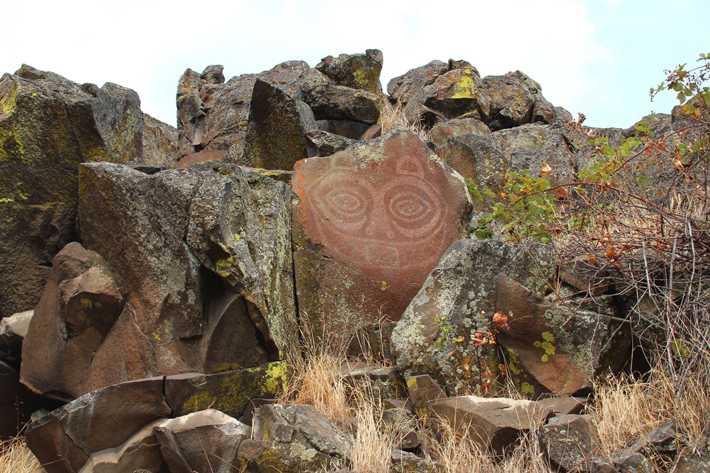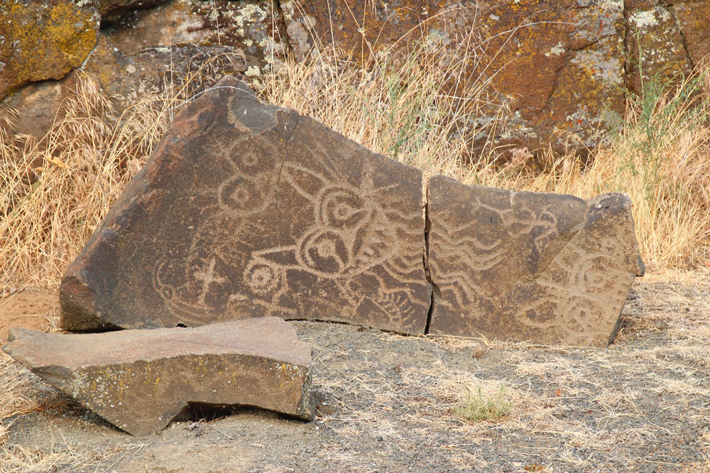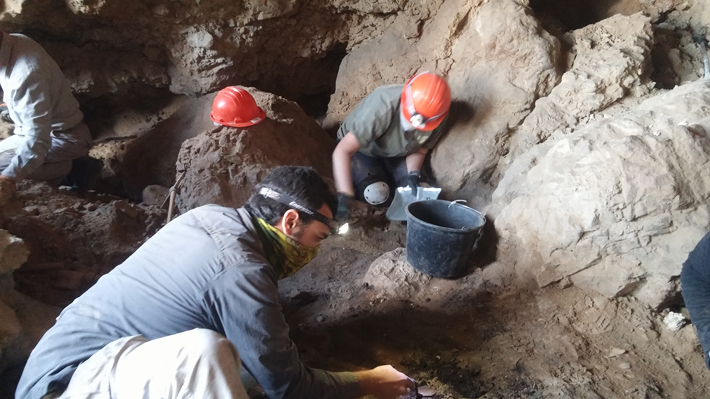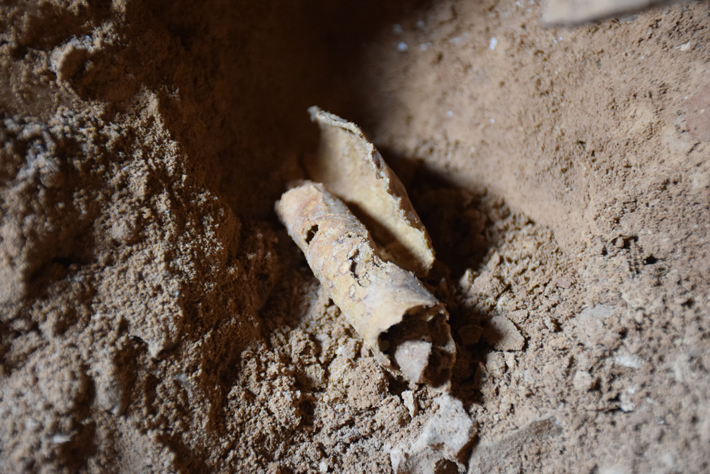From the Trenches
Off the Grid
By MALIN GRUNBERG BANYASZ
Monday, April 10, 2017

In the 1950s, the U.S. government funded the Dalles Dam Project to build hydroelectric capacity for the Northwest and beyond. The project was completed in 1957, but the rising waters behind the dam forever changed a stretch of the river valley separating Washington and Oregon. The area had long been a gathering place for people from the Warm Springs, Yakama, Umatilla, and Nez Perce tribes. Their modern descendants opposed the dam construction and feared that ancient rock art there would be submerged. Although they were not able to stop the project, the tribes were able to save approximately 40 artworks by having them jackhammered out of the cliffs. In the early 2000s, the artworks were taken out of storage and placed in a permanent outdoor display called Tamani Pesh-Wa, or “Written on the Rock,” in Washington’s Columbia Hills Historical State Park, formerly known as Horsethief Lake. There are also some petroglyphs higher on the cliff face in situ. Archaeologist Ken Feder of Central Connecticut State University says, “It’s fortunate that the locals had the presence of mind to figure out a way to preserve some of the rock art before it was lost forever to the floodwaters.”
 THE SITE
THE SITE
The petroglyphs of the Tamani Pesh-Wa display are now easily visible from a walking trail, and depict deer, mountain sheep, hunters, thunderbirds, owls, fish, and a creature with long flowing tentacles. One especially notable work remains high up in the cliff face, and can only be visited with an escort from the park. It is called Tsagaglalal, or “She who watches” in the Wasco-Wishram language. The legend of Tsagaglalal tells of a female chief who was concerned over what would happen to her people when she was gone. Coyote came to her and told her that soon the world would change and that women would no longer be chiefs. Coyote then tricked her and turned her into a rock, saying, “Now you shall stay here forever, watching over your people and the river.”
WHILE YOU'RE THERE
Close to Columbia Hills Historical State Park are the Maryhill Museum of Art and the Columbia Gorge Discovery Center, both of which house artifacts from the local tribes. In the park, the lake provides recreation, and the cliffs are known for excellent rock climbing. Visitors in the spring can expect to see beautiful fields of lupine and balsamroot.
Scroll Search
By DANIEL WEISS
Monday, April 10, 2017

In 1946 or 1947, a Bedouin goatherd found a number of ancient texts in a cave overlooking the Dead Sea and the ruins of the town of Qumran in the West Bank. Searches over the next decade yielded around 900 mostly fragmentary ancient Jewish texts in 11 different caves. These texts, known as the Dead Sea Scrolls, are among the greatest archaeological discoveries of the twentieth century. Written primarily on parchment and papyrus, they date from between the third century B.C. and the first century A.D. and include almost all of the Hebrew Bible, texts related to it known as Apocrypha, and the writings of a Hebrew sect thought to have been based at Qumran, most likely the Essenes. The texts offer valuable insights into debates about Jewish law and ritual—as well as messianic speculation—in the period after the composition of the Hebrew Bible and before the rise of Christianity and Rabbinic Judaism.
Recently, small fragments of texts purported to be from the area have appeared on the antiquities market. Many are thought to be fakes, but they have led to concern that there are undiscovered Dead Sea Scrolls, and that looters are getting to them in advance of archaeologists. In response, the Israel Antiquities Authority has launched Operation Scroll, which aims to survey several hundred caves in the area and excavate ones that may contain texts. In February 2017, archaeologists announced they had discovered a cave in the cliffs west of Qumran near the northwestern shore of the Dead Sea that they believe once held additional Dead Sea Scrolls.
 In a tunnel around 50 feet from the cave’s entrance, archaeologists led by Oren Gutfeld of the Hebrew University in Jerusalem and Randall Price of Liberty University in Virginia unearthed a range of objects, including several broken storage jars of the sort that sometimes contained scrolls, multiple pieces of cloth used to wrap scrolls, straps of leather to tie them, tendons that connect them, and even pieces of blank parchment. “But, unfortunately, the scrolls were not there,” says Gutfeld.
In a tunnel around 50 feet from the cave’s entrance, archaeologists led by Oren Gutfeld of the Hebrew University in Jerusalem and Randall Price of Liberty University in Virginia unearthed a range of objects, including several broken storage jars of the sort that sometimes contained scrolls, multiple pieces of cloth used to wrap scrolls, straps of leather to tie them, tendons that connect them, and even pieces of blank parchment. “But, unfortunately, the scrolls were not there,” says Gutfeld.
Then, hidden between two rocks, they found a pair of pickaxes dating to the 1950s. This, for Gutfeld, was critical. “In my opinion, for sure there were scrolls in this cave that were looted by Bedouins 60 years ago,” he says. “And how can I be so certain? We have everything that is attached to the scrolls. And they left us their pickaxes.”
Robert Cargill of the University of Iowa and other experts aren’t so certain. Cargill points out that many caves in the area have signs of looting. In his opinion, it is the discovery of blank parchment that makes the newly excavated cave significant. Along with previous discoveries at Qumran of inkwells and styluses, remains of animals and materials to remove hair from their hides, and tests showing that ink used to write at least some of the Dead Sea Scrolls was made using water from the Dead Sea, the blank parchment supports the argument that some of the scrolls were produced locally. “The big story is that they found another piece of evidence that the residents of Qumran, whoever they were, could manufacture scrolls,” says Cargill, “not that they found a Dead Sea Scrolls cave.”
For Lawrence Schiffman of New York University, the blank parchment is also the excavation’s most important find, though for a different reason. He sees it as an explanation for how forgers have managed to produce fake Dead Sea Scroll fragments that appear to be genuine based on radiocarbon dating. “It tells us that it is possible to recover blank animal skin material from antiquity that could be used to make fakes,” he says. “Since this cave had some writing material, it may be that other caves had blank writing material as well.”
Advertisement
Advertisement
IN THIS ISSUE
Features
The Wall at the End of the Empire
The Blackener’s Cave
After the Battle
Letter from Greenland
From the Trenches
Scroll Search
Off the Grid
A Cornucopia of Condiments
Bronze Age Bling
Squeezing History from a Turnip
Aurignacian School of Art
Common Ground
Standing Still in Beringia?
The Vikings’ Wide Reach
Close Quarters
The Third Reich’s Arctic Outpost
The Buddha of the Lake
World Roundup
Maya land sharks, exotic libations in Ghana, Viking toy ship, Abu Dhabi’s Neolithic building boom, and the world’s oldest silk
Artifact
How the Maya kings made it rain
Advertisement

Recent Issues
-
 May/June 2024
May/June 2024
-
 March/April 2024
March/April 2024
-
 January/February 2024
January/February 2024
-
 November/December 2023
November/December 2023
-
 September/October 2023
September/October 2023
-
 July/August 2023
July/August 2023
-
 May/June 2023
May/June 2023
-
 March/April 2023
March/April 2023
-
 January/February 2023
January/February 2023
-
 November/December 2022
November/December 2022
-
 September/October 2022
September/October 2022
-
 July/August 2022
July/August 2022
-
 May/June 2022
May/June 2022
-
 March/April 2022
March/April 2022
-
 January/February 2022
January/February 2022
-
 November/December 2021
November/December 2021
-
 September/October 2021
September/October 2021
-
 July/August 2021
July/August 2021
-
 May/June 2021
May/June 2021
-
 March/April 2021
March/April 2021
-
 January/February 2021
January/February 2021
-
 November/December 2020
November/December 2020
-
 September/October 2020
September/October 2020
-
 July/August 2020
July/August 2020
-
 May/June 2020
May/June 2020
-
 March/April 2020
March/April 2020
-
 January/February 2020
January/February 2020
-
 November/December 2019
November/December 2019
-
 September/October 2019
September/October 2019
-
 July/August 2019
July/August 2019
-
 May/June 2019
May/June 2019
-
 March/April 2019
March/April 2019
-
 January/February 2019
January/February 2019
-
 November/December 2018
November/December 2018
-
 September/October 2018
September/October 2018
-
 July/August 2018
July/August 2018
-
 May/June 2018
May/June 2018
-
 March/April 2018
March/April 2018
-
 January/February 2018
January/February 2018
-
 November/December 2017
November/December 2017
-
 September/October 2017
September/October 2017
-
 July/August 2017
July/August 2017
-
 May/June 2017
May/June 2017
-
 March/April 2017
March/April 2017
-
 January/February 2017
January/February 2017
-
 November/December 2016
November/December 2016
-
 September/October 2016
September/October 2016
-
 July/August 2016
July/August 2016
-
 May/June 2016
May/June 2016
-
 March/April 2016
March/April 2016
-
 January/February 2016
January/February 2016
-
 November/December 2015
November/December 2015
-
 September/October 2015
September/October 2015
-
 July/August 2015
July/August 2015
-
 May/June 2015
May/June 2015
-
 March/April 2015
March/April 2015
-
 January/February 2015
January/February 2015
-
 November/December 2014
November/December 2014
-
 September/October 2014
September/October 2014
-
 July/August 2014
July/August 2014
-
 May/June 2014
May/June 2014
-
 March/April 2014
March/April 2014
-
 January/February 2014
January/February 2014
-
 November/December 2013
November/December 2013
-
 September/October 2013
September/October 2013
-
 July/August 2013
July/August 2013
-
 May/June 2013
May/June 2013
-
 March/April 2013
March/April 2013
-
 January/February 2013
January/February 2013
-
 November/December 2012
November/December 2012
-
 September/October 2012
September/October 2012
-
 July/August 2012
July/August 2012
-
 May/June 2012
May/June 2012
-
 March/April 2012
March/April 2012
-
 January/February 2012
January/February 2012
-
 November/December 2011
November/December 2011
-
 September/October 2011
September/October 2011
-
 July/August 2011
July/August 2011
-
 May/June 2011
May/June 2011
-
 March/April 2011
March/April 2011
-
 January/February 2011
January/February 2011
Advertisement






